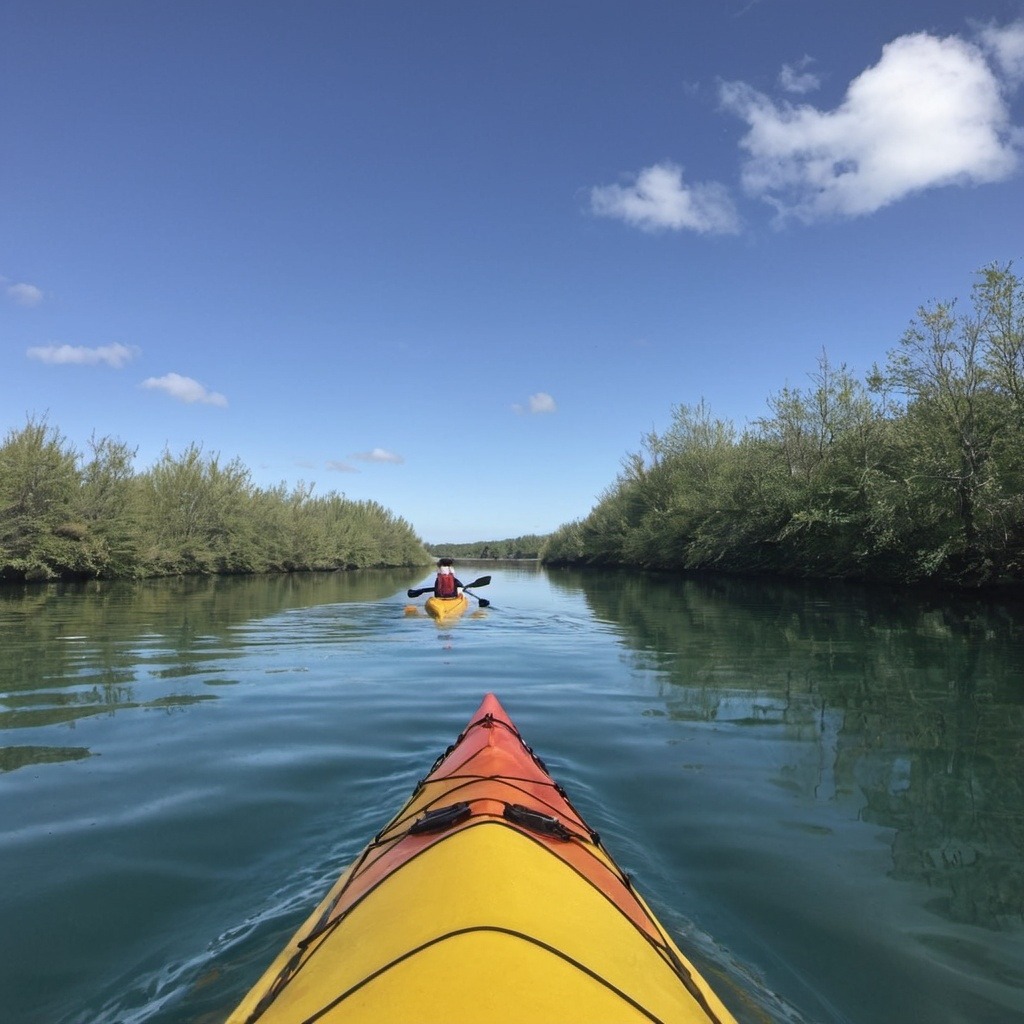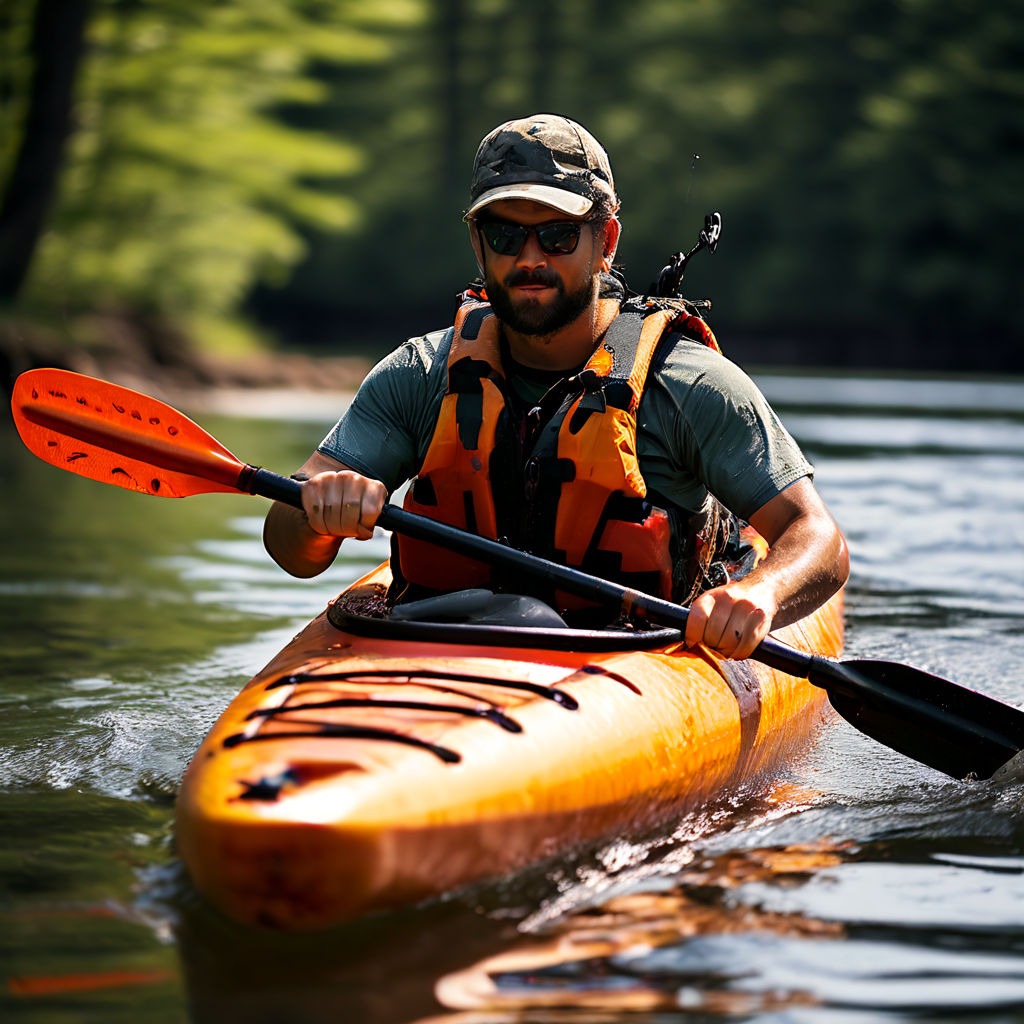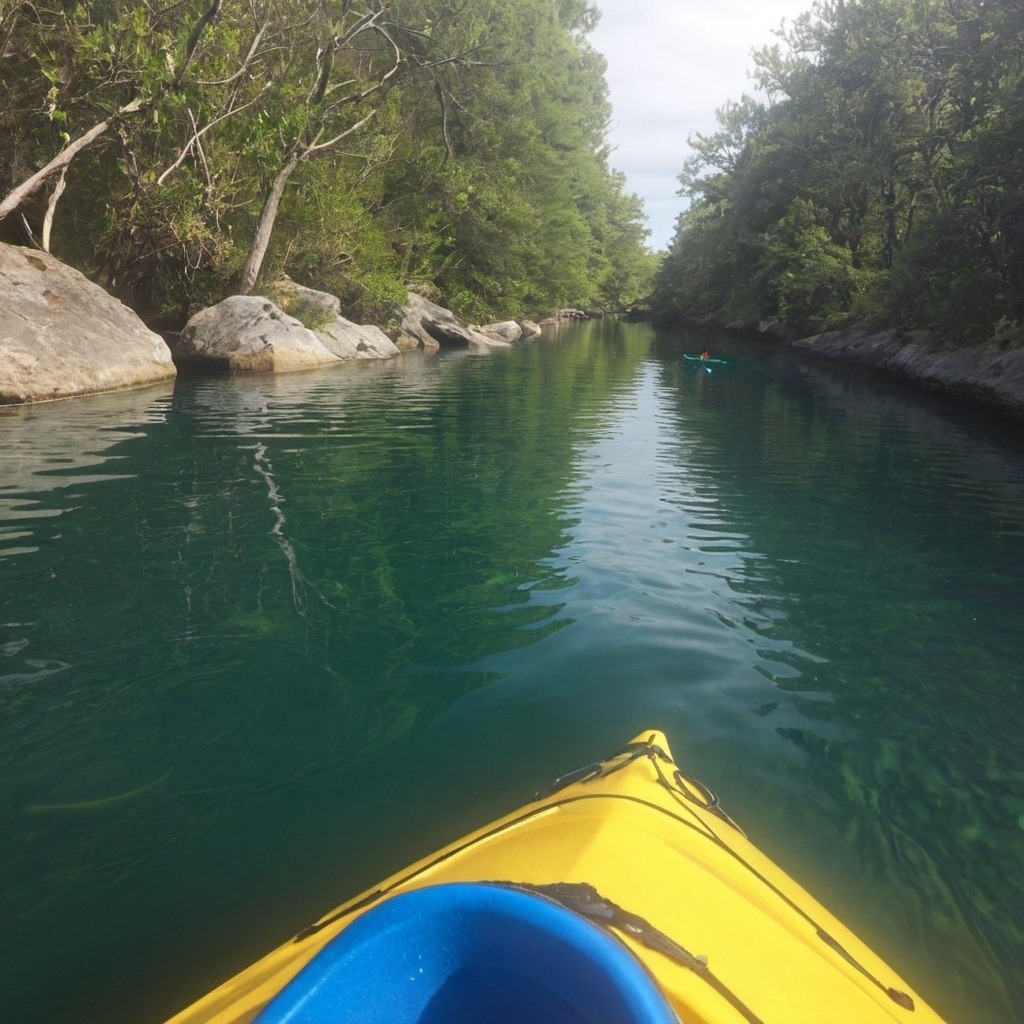
Kayaking is a thrilling and serene way to explore waterways, offering both adventure and tranquility. This water sport involves paddling a small, narrow boat called a kayak through various water bodies, from tranquil lakes to rushing rivers. The rhythmic motion of paddling not only provides a full-body workout but also allows you to immerse yourself in nature, experiencing the beauty of the outdoors up close.
Brief Introduction to Kayaking and Its Benefits
At its core, kayaking is about enjoying the journey. Whether you’re navigating through still waters or tackling gentle waves, kayaking offers a unique blend of excitement and peace. It’s an excellent cardiovascular exercise, engaging muscles in your arms, shoulders, back, and core.
Beyond the physical benefits, kayaking is known to reduce stress and improve mental well-being. The rhythmic paddling, coupled with the calming sounds of water, creates a meditative experience that helps clear the mind and boost your mood.
Why Kayaking is a Great Activity for Beginners
For those new to water sports, kayaking is an ideal starting point. It’s relatively easy to learn, and with the right guidance, beginners can quickly gain confidence on the water. Kayaks are designed to be stable, and beginner-friendly models are particularly forgiving, making it easier to stay balanced. Additionally, kayaking can be as leisurely or as intense as you like, allowing you to set your own pace.
Another advantage is the accessibility of kayaking. You don’t need to live near the ocean to enjoy it; many regions have lakes, rivers, and even rental facilities that provide all the necessary equipment. This accessibility makes it a convenient hobby to pick up and enjoy regularly.
Moreover, kayaking is a social activity that can be enjoyed solo or with friends and family. Joining a local kayaking group or taking a beginner’s class can be a great way to meet new people and learn in a supportive environment. Many places offer guided tours, where experienced kayakers can show you the ropes while exploring scenic routes.
For more information on kayaking basics and finding local classes, you might find resources like the American Canoe Association’s beginner tips helpful. Embrace the adventure of kayaking, and let the water guide you to new experiences and a healthier lifestyle.
Getting Started with Kayaking
Embarking on your kayaking journey begins with understanding the various types of kayaks and selecting the one that suits your needs as a beginner. Here’s a breakdown to help you get started.
Understanding Different Types of Kayaks
Sit-on-Top Kayaks: These kayaks are user-friendly and ideal for beginners. As the name suggests, you sit on top of the kayak rather than inside it. This design provides easy entry and exit, which is particularly useful if you plan to kayak in warmer waters. Sit-on-top kayaks are stable and self-bailing, meaning any water that gets in will drain out through small holes.
Recreational Kayaks: Designed for calm waters such as lakes, slow-moving rivers, and ponds, recreational kayaks are typically wider and shorter. This makes them more stable and easier to maneuver, perfect for those just starting. They also tend to have a larger cockpit, providing more room and comfort.
Touring Kayaks: For those who aspire to take longer trips or explore more challenging waters, touring kayaks are the next step. These kayaks are longer and narrower, designed for speed and efficiency over longer distances. They offer storage space for gear, making them suitable for multi-day excursions. However, they require more skill to handle and are not typically recommended for absolute beginners.
Choosing the Right Kayak for Beginners
When choosing your first kayak, consider where you’ll be kayaking most frequently. For calm, flat waters, a sit-on-top or recreational kayak is often the best choice. These models are stable and forgiving, allowing you to build confidence and skills without worrying about tipping over easily.
Pay attention to the weight and length of the kayak. A shorter kayak (9-12 feet) is generally easier to transport and handle, making it suitable for beginners. Also, ensure the kayak has a comfortable seat and adjustable footrests, which are crucial for maintaining good posture and paddling efficiency.
Essential Kayaking Gear and Equipment
Starting with the right gear is essential for a safe and enjoyable kayaking experience. Here are some must-have items:
Paddle: Choose a lightweight paddle that matches your height and the width of your kayak. A good paddle can make a significant difference in your paddling efficiency and overall comfort.
Life Jacket (PFD): A personal flotation device is a non-negotiable piece of safety equipment. Make sure it fits snugly and allows for a full range of motion.
Clothing: Wear quick-drying and moisture-wicking clothing. In cooler weather, consider wearing a wetsuit or drysuit to stay warm.
Dry Bags: Keep your belongings dry and safe by using dry bags. These waterproof bags come in various sizes and are essential for storing items like your phone, snacks, and extra clothing.
Safety Gear: Equip yourself with a whistle, a bilge pump (for removing water from the kayak), and a towline. In case of emergencies, these items can be lifesavers.
By starting with the right kayak and gear, you’ll set yourself up for a successful and enjoyable kayaking experience. For more detailed guides on choosing equipment, websites like REI’s kayaking guide offer comprehensive advice and recommendations. Happy paddling!
Safety First
Ensuring your safety while kayaking is paramount. While kayaking is generally safe, being prepared and aware of potential hazards can make your experience much more enjoyable and secure.
Importance of Wearing a Life Jacket
Wearing a life jacket, or personal flotation device (PFD), is the single most important safety measure you can take when kayaking. Regardless of your swimming ability, a life jacket can be a lifesaver in case of an unexpected capsize or accident. Modern PFDs are designed to be comfortable and non-restrictive, allowing for a full range of motion while paddling. Always ensure your life jacket fits properly and is correctly fastened. A well-fitted PFD should be snug but not too tight, allowing you to move comfortably without slipping off.
Basic Safety Rules and Precautions
- Learn Basic Swimming Skills: Even with a life jacket, knowing how to swim can significantly increase your safety on the water.
- Stay Sober: Avoid alcohol and drugs before and during kayaking, as they impair your judgment and reaction times.
- Never Paddle Alone: Kayaking with a buddy is safer and more fun. If you do go alone, inform someone about your plans, including your route and expected return time.
- Check Your Equipment: Regularly inspect your kayak and gear to ensure everything is in good working condition. Repair or replace any damaged equipment before heading out.
- Know How to Re-enter Your Kayak: Practice self-rescue techniques, such as re-entering your kayak from the water. This skill is crucial if you capsize far from shore.
Understanding Weather and Water Conditions
Weather and water conditions can change rapidly, and understanding these changes is essential for safe kayaking.
Weather Forecasts: Always check the weather forecast before setting out. Pay attention to wind speeds, as high winds can make paddling difficult and dangerous. Look out for weather advisories and avoid kayaking in stormy conditions.
Water Conditions: Understanding the water conditions of your paddling location is crucial. Calm lakes are ideal for beginners, while rivers and coastal waters require more experience due to currents and waves. Be aware of tidal changes if you are kayaking in coastal areas.
Temperature: Water temperature is a significant factor in safety. Cold water can lead to hypothermia quickly, even in relatively warm air temperatures. Dress appropriately for the water temperature, wearing a wetsuit or drysuit in cold conditions.
Hazards: Identify and avoid potential hazards in the water, such as rocks, submerged trees, or fast-moving currents. Stay clear of areas with heavy boat traffic and always follow local waterway regulations.
By adhering to these safety principles, you can minimize risks and fully enjoy the beauty and excitement of kayaking. For comprehensive safety guidelines, you can refer to resources such as the American Canoe Association’s safety tips. Stay safe and happy paddling!
Basic Kayaking Techniques

Mastering basic kayaking techniques is essential for an enjoyable and efficient paddling experience. Here are some key techniques to help you get started.
Proper Paddling Techniques
To paddle effectively, you need to hold the paddle correctly and use your body efficiently. Start by gripping the paddle with both hands, placing them slightly wider than shoulder-width apart. Hold the paddle so that the blades are vertical when dipped into the water. Position your hands so that your knuckles are aligned with the top edge of the blades.
Sit up straight and engage your core muscles to maintain balance. As you paddle, use a smooth, rhythmic motion, keeping your strokes even and steady. Rotate your torso with each stroke, allowing your larger core muscles to do most of the work, which reduces strain on your arms and shoulders.
How to Enter and Exit a Kayak
Entering and exiting a kayak can be challenging for beginners, but with practice, it becomes second nature. To enter a kayak from a dock or shore, follow these steps:
- Position the kayak parallel to the dock or shore.
- Place your paddle within easy reach.
- Sit on the edge of the dock or shore and swing your legs into the kayak, maintaining your balance.
- Lower yourself into the seat, keeping your weight centered.
To exit the kayak, reverse the process:
- Paddle to a stable, shallow area.
- Position the kayak parallel to the dock or shore.
- Place your paddle within easy reach.
- Lift yourself up using the sides of the kayak or the dock, then swing your legs out and onto the dock or shore.
Basic Strokes
Forward Stroke: The forward stroke is the most basic and essential paddling technique. Hold the paddle with your hands slightly wider than shoulder-width apart. Place the blade of the paddle into the water near your feet and pull it back alongside the kayak, rotating your torso slightly with each stroke. Repeat on the opposite side to propel the kayak forward.
Reverse Stroke: The reverse stroke is used to slow down or move the kayak backward. Hold the paddle with your hands in the same position as for the forward stroke. Place the blade of the paddle into the water near your hips and push it forward alongside the kayak. Alternate sides to maintain balance and control.
Sweep Stroke: The sweep stroke is used to turn the kayak. Hold the paddle with your hands slightly wider than shoulder-width apart. Reach forward with the paddle and place the blade into the water near your feet. Sweep the paddle in a wide arc towards the stern of the kayak, rotating your torso as you do so. This will turn the kayak in the opposite direction of the stroke.
Navigating the Waters
Once you’ve mastered basic paddling techniques, it’s time to learn how to navigate the waters effectively. Understanding water conditions, steering your kayak, and maintaining balance are crucial skills for any kayaker.
Reading the Water and Understanding Currents
Reading the water is an essential skill that helps you anticipate and react to different conditions. Observing the water’s surface can give you valuable clues about what lies beneath and how the water is moving.
Calm Water: Calm, flat water is ideal for beginners as it provides a stable environment to practice your skills. In calm conditions, focus on your paddling technique and enjoy the serene surroundings.
Ripples and Waves: Small ripples and waves can indicate wind or minor currents. These conditions require you to adjust your paddling rhythm and maintain balance. Practice paddling in these conditions to build your confidence.
Currents: Currents are moving water that can push your kayak in different directions. When paddling in rivers or coastal areas, understanding the direction and strength of the current is vital. Look for visual cues such as floating debris, changes in water color, and the flow of nearby objects.
Eddies: Eddies are circular currents often found behind obstacles like rocks or bends in a river. These can provide a calm spot to rest but can also create turbulent water around them.
Recognize and use eddies to your advantage, but proceed with caution.
Steering and Maneuvering Your Kayak

Effective steering and maneuvering ensure you can navigate obstacles and maintain your desired course.
Using the Sweep Stroke: The sweep stroke is your primary tool for turning your kayak. To turn left, perform a wide sweep stroke on the right side of your kayak, and vice versa for turning right. This stroke moves the kayak in the opposite direction of the stroke.
Edging: Edging involves tilting your kayak slightly to one side to assist with turning. By shifting your weight and leaning your body, you can make tighter turns. Practice edging in calm water to get comfortable with the sensation.
Using the Rudder or Skeg: Some kayaks are equipped with a rudder or skeg, which helps with steering and maintaining a straight course. The rudder is controlled with foot pedals, allowing you to steer without using your paddle. A skeg is a fixed fin that helps keep your kayak on track, especially in windy conditions.
Tips for Maintaining Balance
Maintaining balance is crucial for preventing capsizes and ensuring a smooth paddling experience.
Center Your Weight: Keep your weight centered and low in the kayak. Sit up straight and avoid leaning too far in any direction. This stable position helps you stay balanced and in control.
Use Your Core Muscles: Engage your core muscles while paddling. Strong core muscles help stabilize your upper body and distribute your weight evenly.
Look Ahead: Focus on the direction you’re paddling rather than looking down at your kayak. Keeping your head up and looking ahead helps maintain balance and anticipate obstacles.
Practice Bracing: Bracing involves using your paddle to stabilize yourself if you feel unsteady. If you start to tip, quickly place the paddle blade flat on the water’s surface and push down to regain balance.
Common Beginner Mistakes to Avoid
Starting out in kayaking can be incredibly rewarding, but beginners often make a few common mistakes that can hamper their experience. Here are some pitfalls to watch out for and how to avoid them.
Overpacking or Underpacking
When preparing for a kayaking trip, it’s important to strike a balance between being well-prepared and not overburdening yourself with unnecessary gear.
Overpacking: Bringing too much equipment can make your kayak heavy and harder to maneuver. Stick to essential items such as a paddle, life jacket, dry bags for personal belongings, and necessary safety gear. Avoid loading your kayak with bulky items that you won’t need on the water. Overpacking can also affect your balance and stability, increasing the risk of capsizing.
Underpacking: On the flip side, underpacking can leave you unprepared for potential situations. Make sure you have adequate supplies, including enough water, snacks, a first-aid kit, and appropriate clothing for the weather conditions. Failing to bring necessary items can turn a pleasant outing into an uncomfortable or even dangerous situation.
Not Paying Attention to the Surroundings
Being aware of your environment is crucial for safety and navigation while kayaking.
Ignoring Potential Hazards: Beginners might focus too much on their paddling technique and neglect to look out for obstacles in the water, such as rocks, logs, or other watercraft. Always keep an eye on the water ahead and around you to avoid collisions.
Neglecting Weather Changes: Weather conditions can change rapidly, and being caught unaware can be hazardous. Regularly check the weather forecast before heading out and stay vigilant for signs of changing conditions, such as darkening skies or increasing winds. If you notice the weather worsening, head back to shore promptly.
Overlooking Wildlife: While it’s exciting to encounter wildlife, it’s important to keep a safe distance. Getting too close can disturb animals and potentially put you in harm’s way. Respect local wildlife and observe them from afar.
Paddling Too Far from the Shore
Beginners often underestimate the difficulty of paddling back to shore, especially if conditions change.
Straying Too Far: It’s tempting to paddle out into open water, but this can be risky, particularly for novices. Stay within a reasonable distance from the shore where you can quickly return if needed. This is especially important in large bodies of water where currents and wind can make paddling back more challenging than anticipated.
Underestimating Fatigue: Paddling requires physical effort, and beginners might not realize how quickly they can tire. Plan your route and pace yourself to ensure you have enough energy to return to your starting point. Taking regular breaks can help manage fatigue and keep your energy levels steady.
By avoiding these common mistakes, you’ll have a safer and more enjoyable kayaking experience. Stay mindful of what you pack, remain aware of your surroundings, and keep within a safe distance from the shore to ensure your kayaking adventures are both fun and secure. For additional advice on avoiding beginner mistakes, check out resources like Paddle Your State for comprehensive tips and best practices.
